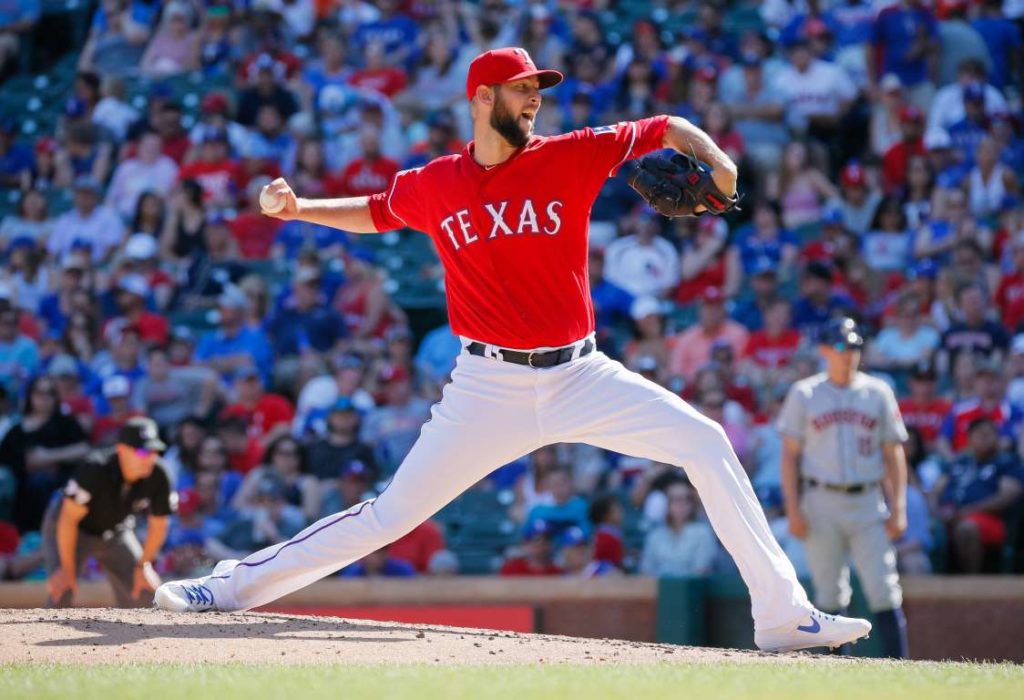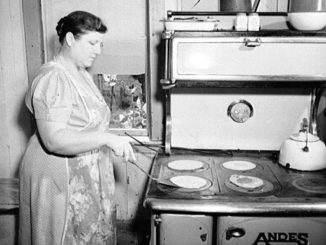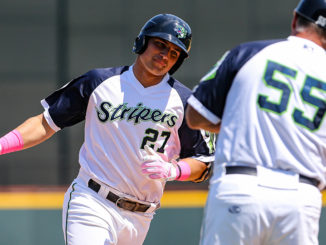
The Trade
Atlanta traded 21 year old LHP Kolby Allard to the Rangers on Tuesday for 33 year old RHP Chris Martin.
Who is Chris Martin?
The reaction from many Braves fans after the announcement of this trade was understandably, “Who?” After cracking a Coldplay joke or two (honestly, the Coldplay jokes are easy and lazy, and we at OFR think y’all can do better than stooping to that level), they flocked to Fangraphs to find out more about the new Atlanta reliever. Don’t panic! I’m here to hopefully give you a good introduction to the relatively unknown righty.
Martin is 0-2 with a 3.08 ERA and 4 saves for Texas in 2019. It’s a breakout season for the 33 year old, whose prior experience, with Colorado in 2014, the Yankees in 2015, and Texas in 2018, inspired little confidence in his abilities. But the breakout looks real. He’s striking out 29.3% of opposing batters and walking just 2.7%. When batters make contact, it goes on the ground pretty often (49%). The ERA is mostly backed up by an impressive 3.28 DRA, telling us the success so far hasn’t been a mirage (ignore any article that bemoans his 4.02 FIP – DRA is more predictive).
Let’s take a look at his arsenal and usage:
Four Seam Fastball – 44% – 96.1 mph
Martin’s four seamer is his bread and butter. It may not go faster than the speed of sound, but at 96 mph, it gives batters problems. Hitters whiff on 28.9% of the time when offering, and the four seamer is his big strikeout pitch. He’ll use it in any count, against any hitter (over 40% of the time against both LH and RH), and he’ll use it well. It’s the kind of pitch that will put a smile on your face.
Let’s watch him use the big four seamer to strike out Kris Bryant:
Sinker – 21.5% – 95.4 mph
While Martin’s four seamer has always been pretty good, his improvement in 2019 is marked by the drastic increase in the use of his sinker. Statcast lists Martin as having thrown only 7 sinkers in all of 2018, just 1% of his pitches. In 2019, that’s up to 124, or 21.5%. At 95 mph, it’s one of the fastest sinkers in the game, and he’ll use it to both generate swings and misses and to induce ground balls. Like the four seamer, he’ll use the sinker regularly against hitters from both sides of the plate. As far as sinkers go, Martin’s doesn’t have a ton of movement, but thrown at nearly the speed of his four seamer, the sinker does its work by just moving slightly differently than his main offering.
Here are a couple of All-Stars struggling against the pitch:
Cutter – 16.5% – 92.0 mph
Martin’s cutter has good movement away from right handed hitters, so he uses it more against righties, where it’s his #2 pitch at 20.5% usage, than against lefties (#4, 12.3%). Like his other fastballs, the cutter is thrown quite hard, around 92 mph, and Martin will use it to get ground balls. Unfortunately, in 2019 hitters have had their most success against this pitch. Righties are batting .357 against the cutter, and that’s the lowest batting average they’ve ever registered against the pitch. Martin will have to use the cutter judiciously. He’ll use it sparingly against lefties, but when he does, it’ll be as a strikeout pitch to sluggers with long swings. It has some sink and can at times move a bit like a slower version of his sinker, leading to a few more early swings and misses. It’s easy to see why he keeps it in his arsenal, but the high hit rate does force it into secondary status.
Changeup – 9.7% – 89.4 mph
From one perspective, Martin’s change has been his best pitch in 2019. After all, he’s thrown in 56 times, and batters have hit .000 against it! Batters mostly just leave it alone, however, as only 14 of those changeups have resulted in some kind of batted ball or strikeout. He’ll use the pitch almost exclusively to left handed batters, which isn’t uncommon. It dives downward, and when batters make contact (which isn’t often), they’ll usually hit it in the air. Former Brave and 2019 All-Star Tommy LaStella isn’t a fan:
Slider – 8.3% – 86.5 mph
Unlike many righties, Martin doesn’t rely on his slider for whiffs. In fact, in 2019, not one batter has swung at the slider and failed to make contact. They fared well against the slider a year ago, batting .333 against the pitch in 2018. This is likely why Martin dialed back its usage so extensively. It’s more looping than the average slider, more noticeable in its drop than its sweep. Here’s what it looks like when things go as intended, with Rafael Devers complying:
But, if a hitter is sitting on slider, it’s an easy pitch to track, and it can get Martin into trouble. Here is Khris Davis being non-compliant:
All in all, Martin is putting together a fine season thanks to embracing his fastballs, particularly the sinker. He should be a reliable reliever for Atlanta down the stretch. Adding to the optimism is that when he pitches under a sky full of Georgia stars, he’ll be in a more favorable environment than when he pitched in Arlington.
Unfortunately, that’s as long as he’ll probably be in Atlanta. Normally, when a team acquires a guy you barely know, it’s because he’s young and controllable. However, Martin went on the adventure of a lifetime, pitching professionally in Japan, and had an unusual contract upon his return – despite just two years of service, he’ll become a free agent at the end of the season.
What Atlanta Traded
Kolby Allard used to rule the Braves prospect world. While the team traded for prospects, the rebuild always relies on the draft, and the 2015 1st round pick was the first such pick. In 2019, Allard sweeps the streets he used to own. However, just because Allard is losing ground in the rankings doesn’t mean he’s lost. Our prospect gurus, Andy Harris and Matt Chrietzbereg, considered Allard to be the 11th best prospect in the deep farm system at the time of the trade, though their estimation of the lefty might have been the kindest – Fangraphs ranked him 23rd. Either way, Texas is getting a potentially useful player.
If Allard were reliably ready for the spotlight on a contender, you would have seen him in Atlanta this season. The Braves haven’t trusted Allard to help out in any jams in a year which has seen numerous pitchers promoted and demoted over and over again. Allard’s absence was telling. And at the same time, he kind of needs to be on a major league mound at this point. Between 2018 and 2019, he has thrown 222.1 innings at AAA, and those innings have been mostly competent. Allard probably needs to be on a major league mound, but understandably, Atlanta doesn’t want to rely on him for important innings in 2019.
The trade, therefore, makes a lot of sense. Allard can get on the mound in Texas, and perhaps, as a lefty, he can mitigate some of the damage he’d otherwise take in Arlington. It’s not an ideal landing spot for a pitcher without a history of ground ball prowess, one who allowed three homers in his eight career MLB innings. But any landing spot outside the pennant chase is a good one, as it will give Allard a chance to grow at the MLB level, which is what he’s ready for. Texas can justify letting him learn from both his successes and failures, whereas Atlanta could only afford the former. Here’s wishing Allard the best of luck going forward.
Final Thoughts
I won’t do my normal exercise of tabulating WAR/$ valuations, because as long as they’re somewhat in the ballpark, they’re fine in this case. The Braves have a need for better relief pitching. They gave up an asset that seemed a bit out of place in the current state of things. An extension for Martin almost certainly isn’t going to happen (fans always mention that at the time of a trade, but they’re quite rare), but this does give the Braves a first hand look at Martin for when he does hit free agency at the end of the year. Atlanta will have the best and most recent info on an interesting free agent, and that’s not a bad thing.
It’s hard to think of this as anything but a good trade for Atlanta. Martin’s leap forward is not just random noise – it’s fundamentally based on a change in his approach on the mound and backed up by impressive velocity. He may not be the singular difference between this team and baseball paradise, but he’s probably going to be helpful down the stretch and into October. And while Kolby Allard could certainly reverse course and put everything together, I’m guessing his ceiling is probably that of a below average MLB starter (though Andy could certainly put me in my place on that point).
Is Atlanta done? Does Alex Anthopoulos, the scientist behind the roster construction, look at this rotation, bullpen, or outfield and still think, “I will fix you?” The trade deadline can be a bit like a rush of blood to the head, a whirlwind of information and rumors, and it’s an exciting time. We have a few hours left of watching our clocks and twitter in equal measure. And then, we’ll have just 3 more months of this incredibly fun team and its stars. Enjoy how they shine for you, and hope the Braves can avoid baseball death and all his friends for as long as possible.




Leave a Reply